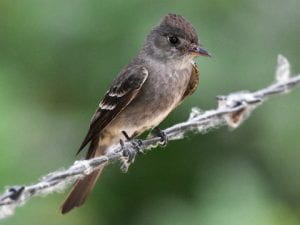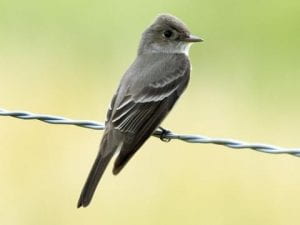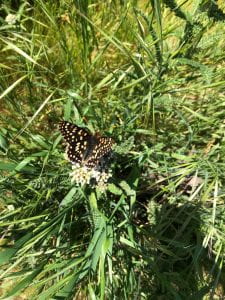Ebird List Link: https://ebird.org/checklist/S67699129
Date: 04/23/20
Location: Presidio of San Francisco, San Fransisco County ( 37.78738, -122.47458) at an elevation of approximately 243 feet (74 meters). Refer to the map for where observations were recorded.
Site Description: Observations were done along a trail in the Presidio. The site consisted of a series of rolling hills at a moderate elevation. The majority of the observations were done along the cemented footpath on the trail, which ran along the edge of a cliff overlooking the coast and open-aired area at the highest elevation. The footpath was bordered by a variety of medium-height trees and a dense amount of bushes. Some observations were taken down at a lower elevation, which had dense amounts of tall gum trees and pine trees with some grasses. The most abundantly observed species were: American Crows (43), Turkey Vultures (8), Anna’s Hummingbirds (5), Common Ravens (4), Rufous Hummingbirds (4), White-crowned Sparrows (4), Red-tailed Hawks (3), and American Robins (3). Other species observed were: Gull species (2), House Finches (2), Song Sparrows (2), a Mourning Dove (1), a Double-crested Cormorant (1), a Great Blue Heron (1), a Western Wood-Peewee (1), a California Scrub-Jay (1), and a White-throated Sparrow (1).
Species Account: My attention was drawn to a bird perched on top of a bush, calling in spaced-out high pitched buzzes. Listening closely, I would say that the vocalization was slightly oscillating between a higher and lower pitch. The bird was not far from me, so I was able to get a detailed look at its morphology. Upon first glance, I thought that it was a Black Phoebe because of the uniquely shaped head. The plumage atop of the head led up to a rounded point near the center of the skull. The subtle white wing bars I had observed in Black Phoebes were also present in this bird. However, there were some differences I noticed that led me to speculate it may have been another species. The majority of the body plumage was a grey color, lighter than the black color I had consistently observed in the Black Phoebes. I did note that this may just be due to variation within the species, but the body shape furthered my speculation it was actually was a different species. The body of this bird was narrow with a more pointed tail compared to the Phoebe’s rounded body and blunted tail. My identification of the bird based on morphology was that it was a Western Wood-Pewee. Western Wood Pe-wees (Contopus sordidulus) are of the order Passeriformes and of family Tyrannidae. They are medium-sized flycatchers that have a peaked crown, giving them a triangular looking shaped head. Their bodies are long and slender, the longer length of the Western Wood-Pewee’s wings differentiates it from other similar looking flycatcher species. The majority of their plumage is a grayish-brown color, with two white wing bars and a lighter gray on their underside. Western Wood Pewee’s are often said to look like they are wearing a partially buttoned gray vest. Their peaks are small and pointed, suited to their diet of insects. This species is known for its perching behavior when hunting they often return to the same initial perch. A key identifying behavior is that this species does not flick its tail while perched, like many species of flycatchers, do. The Western Wood-Pewee’s call is a reflection of its name, they sing “pewee” in a tone best described as burly and nasally. This species mainly inhabits open woodlands, forest edges, and forests near streams with large trees. They tend to avoid dense forests. The Western and Eastern Wood-Pewees are nearly identical morphologically and having breeding zones that overlap in a narrow area in the Great Plains. Despite this, no evidence has been found that the two species interbreed in this area. It is suspected that breeding may not occur because of how different each species’ song is.


Sources:
- “Western Wood-Pewee – Ebird.” Ebird.Org. https://ebird.org/species/wewpew. Accessed 26 April 2020
- “Western Wood-Pewee – All About Birds.” Allaboutbirds.Org. https://www.allaboutbirds.org/guide/Western_Wood-Pewee. Accessed 26 April 2020
Narrative: Observations occurred along a trail over 0.55 miles. The weather was sunny with clear skies. The temperature was between 60-65 degrees Fahrenheit. A moderate diversity of species was observed with a low abundance of each, however, there was an exception with the American Crows, which had a high abundance. Over the duration of the trip (64 minutes), fifteen species were observed. The American Crows I observed were all at once, flying chaotically in a large flock in a circular motion. I believe they were potentially exhibiting group hunting behavior or competing over food. I had difficulty identifying crows from ravens, after remembering that crows have fan-like tails while ravens have more diamond-shaped tails. I was able to confirm that the members of the flock were indeed American Crows based off of tail morphology. As I saw on my last visit, the Anna’s Hummingbirds were still doing their mating displays, flying up high in a straight line then quickly diving down into a J-shape. I believe that I actually observed a male Anna’s Hummingbird attempting to impress a female because the male was being more vocal than I had ever heard before. The male was also zipping very quickly around one specific bush while he was vocalizing. Another interesting thing I noticed was plumage on a pair of House Finches. As I walked, a brilliant bright red color upon the telephone wire caught my eye. At first, I assumed it was an Anna’s Hummingbird with direct sunlight hitting its plumage. I find that the hummingbirds often perch on this telephone wire. However, the bird was much too large to be a hummingbird species. When I looked with my binoculars, the bird more so resembled a sparrow body type with a long tail. I was then able to identify the pair of birds as finches, the red color I observed was consistent with House Finches.
Additional Photos and Media:




